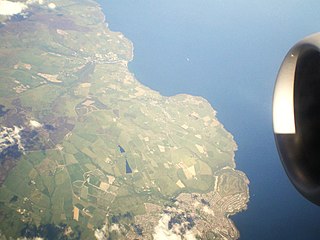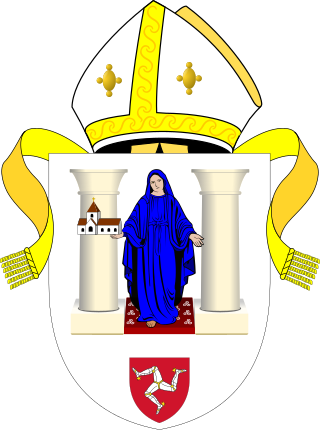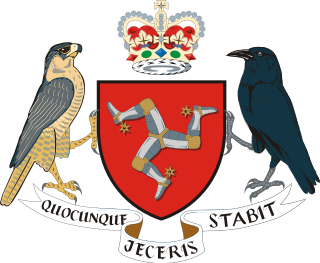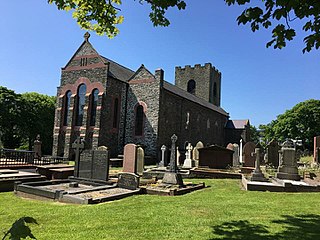
Castletown is a town in the Isle of Man, geographically within the historical parish of Malew but administered separately. Lying at the south of the island, it was the Manx capital until 1869. The centre of town is dominated by Castle Rushen, a well-preserved medieval castle, originally built for a Viking king.

Onchan is a large village in the parish of Onchan on the Isle of Man. It is at the north end of Douglas Bay. Administratively a district, it has the second largest population of settlements on the island, after Douglas, with which it forms a conurbation.

Peel is a seaside town and small fishing port in the Isle of Man, in the historic parish of German but administered separately. Peel is the third largest town in the island after Douglas and Ramsey but the fourth largest settlement, as Onchan has the second largest population but is classified as a village.

The Diocese of Sodor and Man is a diocese of the Church of England. Originally much larger, today it covers just the Isle of Man and its adjacent islets. Today, the bishop's office is in Douglas and the cathedral is in Peel. The diocese is not generally called either "Sodor diocese" or "Man diocese".

The Cathedral Church of Saint German or Peel Cathedral, renamed Cathedral Isle of Man, is located in Peel, Isle of Man. The cathedral is also one of the parish churches in the parish of the West Coast, which includes the town of Peel. Built in 1879–84, it was made the cathedral by Act of Tynwald in 1980.

Michael is one of the six sheadings of the Isle of Man. It is located on the west of the island and consists of the three historic parishes of Ballaugh, Jurby and Michael.

The Vicar General of the Diocese of Sodor and Man is an ecclesiastical law officer appointed by the Bishop of Sodor and Man.

St Ninian's Crossroads is situated between the TT Grandstand and the 1st Milestone road-side marker on the Snaefell Mountain Course on the primary A2 Douglas to Ramsey road in the town of Douglas in the Isle of Man.

Thomas Wortley Drury was a British Anglican bishop who served as Master of St Catharine's College, Cambridge from 1920.
Ballakermeen High School is a coeducational comprehensive secondary school based on a single site in Douglas, on the Isle of Man. It is the second largest Isle of Man Government building after Noble's Hospital in Strang. On the start of the 2022/2023 academic year, a new head teacher was appointed, Mr Graeme Corrin, replacing Mrs Adrienne Burnnet, who was Head Teacher for 21 years.
Henry Bridgeman was an Anglican clergyman who served in the Church of England as the Bishop of Sodor and Man from 1671 to 1682.
John Meyrick, M.A. was an Anglican clergyman who served in the Church of England as the Bishop of Sodor and Man from 1576 to 1599.

Josephine Kermode (1852–1937) was a Manx poet and playwright better known by the pen name "Cushag".

The St Mary of the Isle Cathedral, also referred to as the Cathedral of St Mary of the Isle, is a Roman Catholic cathedral in Douglas, Isle of Man. It is part of the Roman Catholic Pastoral Area of St Maughold within the Archdiocese of Liverpool. It is one of two cathedrals on the Island, and one of six Catholic churches. It is referred to locally as St. Mary's. In September 2023, St Mary of the Isle was granted co-cathedral status.

Samuel Harris QC was a Manx advocate, businessman and philanthropist who became High Bailiff of Douglas and a member of the Legislative Council of the Isle of Man. He was also a founder of the Isle of Man Bank and a director of the Isle of Man Steam Packet Company.

All Saints Church, Douglas, Isle of Man, is a 1967 Modernist Anglican church which closed in May 2017.

Henry Bloom Noble JP was a Cumbrian-born philanthropist and businessman who at the time of his death was the richest resident of the Isle of Man. Noble bequeathed a large amount of his vast fortune to the people of the Isle of Man, resulting in numerous civic amenities such as recreation grounds, swimming baths, a library and a hospital.

St George's Church is an Anglican church in Douglas, Isle of Man and falls within the Diocese of Sodor and Man. It was formerly one of two worship centres in association with All Saints Church, Douglas.

St Trinian's Church is the roofless ruin of a small chapel at the foot of Greeba Mountain, adjacent to the main A1 Douglas - Peel Road in the parish of Marown, Isle of Man. Referred to in the Manx language as a "Keeil Brisht", the church is the source of an ancient Manx folktale concerning the Buggane, a huge mythical ogre who lived on Greeba Mountain and who vowed that the church should never be completed.

Arthur Binns Crookall JP, MLC, CP, was a philanthropist, Mayor of the Borough of Douglas, a member of both branches of Tynwald, Chairman of the Isle of Man Steam Packet Company and Chairman of the Isle of Man Railway Company who at his death was one of the wealthiest people on the Isle of Man.



















